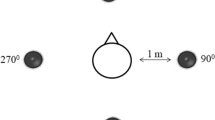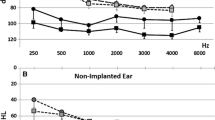Abstract
Katz (1978) has suggested that mild, fluctuating conductive hearing loss due to middle-ear anomalies may account for the language and attention problems of learning-disabled children. His position was extended here to include autism. Normal, learning-disabled, and autistic children received repeated impedance measures over 5 weeks. A repeated-measures ANOVA of central tendency and variablility values led to the conclusions that (1) fluctuating, negative middle-ear pressure greater than normal characterizes both autistic and learning-disabled children, (2) the negative pressure is greater in autistic than in learning-disabled children, and (3) the condition is typically bilateral for autistic children.
Similar content being viewed by others
References
Battin, R. R. (1982). Developmental effects of early middle ear disorders.Journal of the American Academy of Private Practice in Speech Pathology and Audiology, 4, 31–32.
Cooper, J., Gates, G., Owen, J., & Dicksen, H. (1976). An abbreviated impedance bridge technique for school screening (pp. 373–379). In J. L. Northern (Ed.),Selected readings in impedance audiometry. New York: American Electromedics.
deQuieros, J. B. (1976). Diagnosis of vestibular disorders in the learning disabled.Journal of Learning Disabilities, 9, 37–50.
Downs, M. P. (1981). Amplification in the habilitation of the young deaf child. In G. T. Mencher & S. E. Gerber (Eds.),Early management of hearing loss (pp. 199–224). New York: Grune and Stratton.
Edelbrock, C., Costello, A. J., & Kessler, M. (1984). Empirical corroboration of attention deficit disorder.Journal of the American Academy of Child Psychiatry, 23, 285–290.
Feldman, A. S. (1975). Acoustic impedance-admittance measurements. In L. J. Bradford (Ed.),Physiological measures of the audio-vestibular system. New York: Academic Press.
Ginsberg, I. A., & White, T. P. (1978). Otological considerations in audiology. In J. Katz (Ed.),Handbook of clinical audiology (2nd ed., Chap. 2). Baltimore: William & Wilkins.
Gordon, A. G. (1977). Fluctuating deafness and autism.Journal of Autism and Developmental Disorders, 7, 115–116.
Hayes, R. W., & Gordon, A. G., (1977). Auditory abnormalities in autistic children,Lancet, 2, 767.
Holm, V. A., & Kunze, L. V. H. (1969). Effect of chronic otitis media on language and speech development.Pediatrics, 13, 833–839.
Holmquist, J., & Miller, J. (1972). Eustachian tube evaluation using the impedance bridge.Mayo Foundation Impedance Symposium (pp. 297–307). Rochester, Minnesota: Mayo Foundation.
Katz, J. (1978). The effects of conductive hearing loss on auditory function.Journal of the American Speech and Hearing Association, 20, 879–886.
Keating, C. L. (1977).The relationship between the vestibular system, dyslexia, and reading in a selected population: A clinical study. Unpublished doctoral dissertation, University of Michigan.
King, C., & Young, R. D. (1982). Attentional deficits with and without hyperactivity: Teacher and peer perceptions.Journal of Abnormal Child Psychology, 10, 483–496.
Koegel, K. L., & Schreibman, L. (1976). Identification of consistent responding to auditory stimuli by a functionally “deaf” autistic child.Journal of Autism and Childhood Schizophrenia, 6, 147–156.
Konieczny, B. J. (1977).Physiological correlations between the auropalpebral reflex, cardiac rate and arbitrarily defined behavioral states in autistic children. Unpublished manuscript, University of Michigan.
Konieczny, B. J., & Milburn, W. O. (1975).Behavioral states observed in non-symbolic language of children with autistic symptoms. Unpublished manuscript, University of Michigan.
Krug, D. A., Arick, J. R., & Almond, P. A. (1980).Autism screening instrument for educational planning. Portland, Oregon: ASIEP Educational Co.
Lahey, B. B., Schaughency, E. A., Strauss, C. C., & Frame, C. L. (1984). Are attention deficit disorders with and without hyperactivity similar or dissimilar disorders?Journal of the American Academy of Child Psychiatry, 23, 302–309.
Masters, L., & Marsh, G. E. (1978). Middle ear pathology as a factor in learning disabilities.Journal of Learning Disabilities, 11, 54–57.
McCandless, G., & Thomas, G. (1976). Impedance audiometry as a screening procedure for middle ear disease. In J. L. Northern (Ed.),Selected readings in impedance audiometry (pp. 369–372). New York: American Electromedics.
Michigan Special Education Rules. (1980). Lansing, Michigan: Michigan State Board of Education.
Needleman, H., & Menyuk, P. (1977). Effects of hearing loss from early recurrent otitis media on speech and language development. In B. Jaffe (Ed.),Hearing loss in children (Chap. 44). Baltimore: University Park Press.
Northern, J. L., & Grimes, A. M. (1978). Introduction to acoustic impedance. In J. Katz (Ed.),Handbook of clinical audiology (2nd ed., Chap. 29). Baltimore: William & Wilkins
Ornitz, E. W. (1985). Neurophysiology of infantile autism.Journal of the American Academy of Child Psychiatry, 24, 251–262.
Ornitz, E. W., & Ritvo, E. R. (1976). The symdrome of autism: A critical review.American Journal of Psychiatry, 133, 609–621.
Routh, D. K. (1979). Activity, attention and aggression in learning disabled children.Journal of Clinical Child Psychology, 8, 183–187.
Shepard, L., Smith, M., & Vojir, C. (1983). Characteristics of pupils identified as learning disabled.American Educational Research Journal, 20, 309–331.
Skinner, M. W. (1978). The hearing of speech during language acquistition.Otolaryngological Clinics of North America, 11, 631–650.
Smith, D. E. P., McConnell, J. V., Walter, T. L., & Miller, S. D. (1985). The effect of using an auditory trainer on the attentional, language, and social behaviors of autistic children.Journal of Autism and Developmental Disorders, 15, 285–302.
Ventry, I. M. (1980). Effects of conductive hearing loss: Fact or fiction.Journal of Speech and Hearing Disorders, 45, 143–156.
Author information
Authors and Affiliations
Additional information
This research, project title “Language and Sensory Stimulation in Autistic Children,” was made possible by a grant from the National Institutes of Mental Health (No. MH37035-02).
Rights and permissions
About this article
Cite this article
Smith, D.E.P., Miller, S.D., Stewart, M. et al. Conductive hearing loss in autistic, learning-disabled, and normal children. J Autism Dev Disord 18, 53–65 (1988). https://doi.org/10.1007/BF02211818
Issue Date:
DOI: https://doi.org/10.1007/BF02211818




